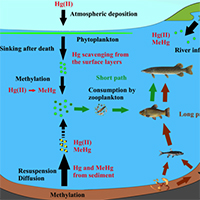Mercury methylation in oxic aquatic macro-environments: a review

Accepted: 27 February 2021
HTML: 106
All claims expressed in this article are solely those of the authors and do not necessarily represent those of their affiliated organizations, or those of the publisher, the editors and the reviewers. Any product that may be evaluated in this article or claim that may be made by its manufacturer is not guaranteed or endorsed by the publisher.
Authors
Mercury methylation in aquatic environments is a key process that incorporates this neurotoxin into the food chain and ultimately the human diet. Mercury methylation is considered to be essentially biotic and mainly driven by sulfate-reducing bacteria present in the bottom sediments in aquatic systems. However, in recent decades, many researchers have shown that this methylation also occurs in oxic layers in conjunction with a high content of particulate organic matter and localized depletion of dissolved oxygen. The goals of this review are to summarize our current understanding of Hg methylation in water columns of both marine and freshwater environments, as well as to highlight knowledge gaps and future research needs. Most of the literature showed that suspended particles (known as marine and lake snow) could be the microenvironment in which Hg methylation could occur across oxic water columns, because they have been recognized as a site of organic matter mineralization and as presenting oxygen gradients around and inside them. To date, the majority of these studies concern marine environments, highlighting the need for more studies in freshwater environments, particularly lacustrine systems. Investigating this new methylmercury production environment is essential for a better understanding of methylmercury incorporation into the trophic chain. In this review, we also propose a model which attempts to highlight the relative importance of a MeHg epilimnetic path over a MeHg benthic-hypolimnetic path, especially in deep lakes. We believe that this model could help to better focus future scientific efforts in limnic environments regarding the MeHg cycle.
Edited by
Diego Fontaneto, CNR-IRSA, Verbania, ItalyHow to Cite

This work is licensed under a Creative Commons Attribution-NonCommercial 4.0 International License.
Similar Articles
- Brigitte HINDER, Isabel BAUR, Kurt HANSELMANN, Ferdinand SCHANZ, Microbial food web in an oligotrophic high mountain lake (Jöri Lake III, Switzerland) , Journal of Limnology: Vol. 58 No. 2 (1999)
- Michele Cesari, Roberto Guidetti, Lorena Rebecchi, Ilaria Giovannini, Roberto Bertolani, A DNA barcoding approach in the study of tardigrades , Journal of Limnology: Vol. 72 No. s1 (2013): 12th International Symposium on Tardigrada
- David G. Jenkins, Lakes and rivers as microcosms, version 2.0 , Journal of Limnology: Vol. 73 No. s1 (2014): Limnology in the 21st Century: celebrating 75 years of ecological research in Pallanza
- Robert STURM, Freshwater molluscs in mountain lakes of the Eastern Alps (Austria): relationship between environmental variables and lake colonization , Journal of Limnology: Vol. 66 No. 2 (2007)
- Nico SALMASO, Ecological patterns of phytoplankton assemblages in Lake Garda: seasonal, spatial and historical features , Journal of Limnology: Vol. 61 No. 1 (2002)
- Oscar RAVERA, An index for estimating the potential impact on the environment of the pollutant content in aquatic populations , Journal of Limnology: Vol. 67 No. 1 (2008)
- Katsumi Matsumoto, Kathy S. Tokos, Joseph Rippke, Climate projection of Lake Superior under a future warming scenario , Journal of Limnology: Vol. 78 No. 3 (2019)
- Walter AMBROSETTI, Luigi BARBANTI, Temperature, heat content, mixing and stability in Lake Orta: a pluriannual investigation , Journal of Limnology: Vol. 60 No. 1 (2001)
- Matteo PERINI, Federica CAMIN, Flavio CORRADINI, Ulrike OBERTEGGER, Giovanna FLAIM, Use of δ18O in the interpretation of hydrological dynamics in lakes , Journal of Limnology: Vol. 68 No. 2 (2009)
- Johan C. VAREKAMP, Lake contamination models for evolution towards steady state , Journal of Limnology: Vol. 62 No. s1 (2003): Residence Time in Lakes: Science, Management, Education
<< < 58 59 60 61 62 63 64 65 66 67 > >>
You may also start an advanced similarity search for this article.
-
Juanjo RodríguezFrontiers in Marine Science : 2023
-
Thibaut Cossart, Javier Garcia-Calleja, João P. Santos, Elaheh Lotfi Kalahroodi, Isabelle A. M. Worms, Zoyne Pedrero, David Amouroux, Vera I. Slaveykova, Kevin WilkinsonEnvironmental Chemistry : 2022
-
Eric Capo, Claudia Cosio, Elena Gascón Díez, Jean-Luc Loizeau, Elsa Mendes, Thierry Adatte, Sören Franzenburg, Andrea G. BravoWater Research : 2023
-
Laura Marziali, Roberta Piscia, Lucia Valsecchi, Claudio Roscioli, Marina MancaWater : 2022
-
Laura Balzer, Carluvy Baptista-Salazar, Sofi Jonsson, Harald BiesterBiogeosciences : 2023
-
Diva Scuvée, Marisol Goñi-Urriza, Claire Gassie, Bahia Khalfaoui-Hassani, Rémy GuyoneaudMicrobiological Research : 2023
-
María del Carmen Diéguez, Marina Arcagni, Andrea Rizzo, Soledad Pérez Catán, Carolina Soto Cárdenas, Milena Horvat, Sergio Ribeiro GuevaraNatural and Social Sciences of Patagonia : 2022
-
Vincent Noël, Kristin Boye, Hannah R. Naughton, Emily M. Lacroix, Meret Aeppli, Naresh Kumar, Scott Fendorf, Samuel M. WebbFrontiers in Environmental Chemistry : 2024
-
Daniel González-Reguero, Marina Robas-Mora, Agustín Probanza Lobo, Pedro Antonio Jiménez GómezWorld Journal of Microbiology and Biotechnology : 2023

 https://doi.org/10.4081/jlimnol.2021.2007
https://doi.org/10.4081/jlimnol.2021.2007





